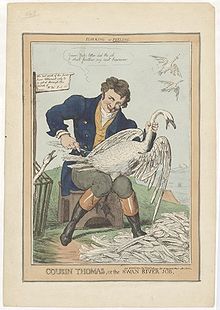Thomas Peel
| Thomas Peel | |
|---|---|

No photograph or portrait of Thomas Peel is known to exist. This is a contemporary caricature.
|
|
| Born | 1793 Lancashire, England |
| Died | 1865 Mandurah, Western Australia |
| Nationality | British Australian |
| Education | Harrow School |
| Occupation | Settler |
| Relatives | Sir Robert Peel (second cousin) |
Mr. Peel, he moans, took him from England to Swan River, West Australia, means of subsistence and of production to the amount of £50,000. Mr. Peel had the foresight to bring with him, besides, 300 persons of the working-class, men, women, and children. Once arrived at his destination, "Mr. Peel was left without a servant to make his bed or fetch him water from the river." Unhappy Mr. Peel who provided for everything except the export of English modes of production to Swan River. —Karl Marx, Das Kapital, volume one, chapter 33.
Thomas Peel (1793–1865) was one of the very early settlers of Western Australia. He was a second cousin of Sir Robert Peel.
Thomas Peel was born in Lancashire, England, the second son of Thomas Peel and his wife Dorothy, née Bolton. He was educated at Harrow School and was employed by attorneys.
In 1828, he went to London with plans to migrate to New South Wales. However, Peel and three others including an MP, Potter McQueen, formed a consortium to found a colony at the Swan River in Western Australia by sending settlers there with stock and necessary materials. The consortium requested a grant from the British Colonial Office in London of 4,000,000 acres (16,000 km²). The government declined this and offered a grant of 1,000,000 acres (4,000 km²) on certain conditions.
Early in 1829, all the members of the consortium withdrew except Peel. Fresh conditions were made, the final arrangement being that if Peel landed 400 settlers before 1 November 1829, he would receive 250,000 acres (1,000 km²). If the conditions were fulfilled, Peel would receive further grants. Solomon Levey was a silent partner.
He arrived in Swan River Colony (later expanded and renamed Western Australia) aboard the Gilmore in December 1829 with 300 settlers, around six weeks later than the government had stipulated. As he had not fulfilled the conditions, the land grant was no longer reserved for him. The land eventually granted to him, 250,000 acres (1,000 km²) of land to the south, extended from Cockburn Sound to the Murray River. He named the settlement Clarence, after the Duke of Clarence.
...
Wikipedia
